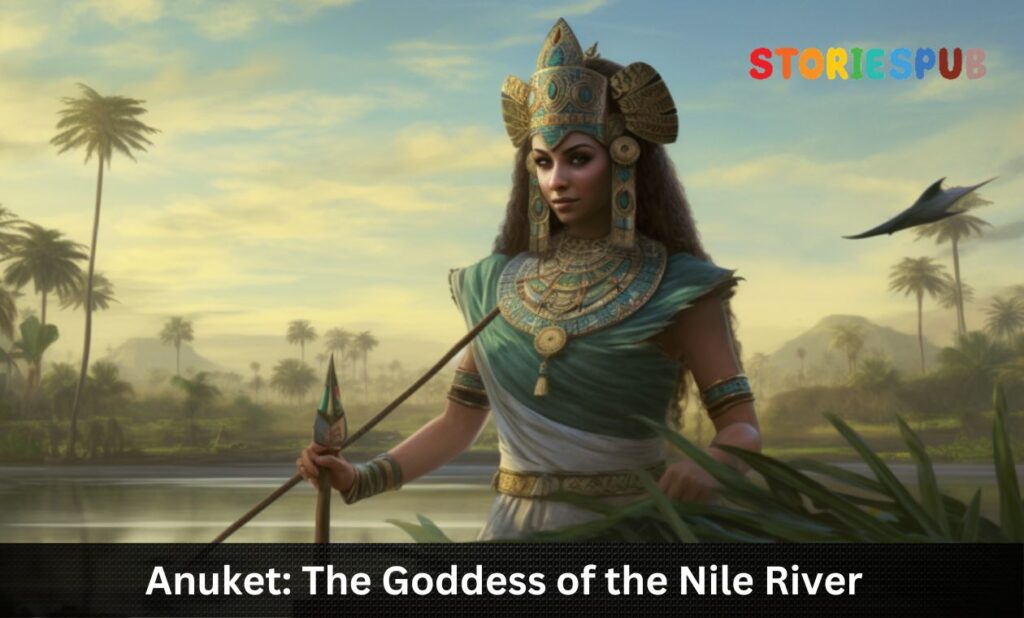Summarize this Article with:
Anuket: The Goddess of the Nile River

Introduction
Egyptian mythology is one of the most fascinating and mysterious aspects of ancient Egypt. The gods and goddesses of ancient Egypt were an essential part of everyday life, and their worship played a crucial role in shaping Egyptian culture.
At the center of this pantheon was Anuket, the goddess of the Nile River. Anuket was one of the most important goddesses in ancient Egypt.
She was worshipped primarily as a fertility deity, associated with the annual flooding of the Nile River. According to Egyptian mythology, she was responsible for making sure that the water level in the Nile remained at a consistent level throughout each year.
Brief Overview on Ancient Egyptian Gods and Goddesses
The ancient Egyptians believed in a vast number of gods and goddesses who controlled different aspects of their lives. Each deity had its own unique powers and responsibilities, such as fertility, agriculture, war, love, and death.
The Egyptians believed that their deities lived among them on Earth and that they needed to be appeased through offerings and prayers to ensure their continued protection. They also believed that certain deities would help them achieve specific goals or overcome particular challenges in life.
The Egyptians worshipped their gods through elaborate ceremonies and rituals conducted by priests in massive temples built throughout Egypt. These temples were dedicated to specific deities who were honored with statues and images depicting them in various forms.
Introducing Anuket
At the center of this vast pantheon was Anuket – a powerful fertility goddess whose role as protector over the Nile River made her one of Egypt’s most revered deities. Her name means “the Clasper,” which refers to her ability to hold back or release water from the Nile according to her will. Anuket was typically depicted as a woman wearing a headdress of ostrich feathers, holding a scepter or wand in one hand and an ankh, the symbol of life, in the other.
She was often shown with a crown of reeds and flowers, which symbolized her association with the river. As the goddess of fertility and abundance, Anuket was also associated with childbirth and nursing.
She was believed to have helped mothers during childbirth and to have provided nourishment for infants through her magical powers. Anuket remains an essential figure in Egyptian mythology for her role as the protector of the Nile River.
Her worship played a crucial role in ancient Egyptian culture, as she represented fertility and abundance, which were essential for their society’s survival. In subsequent sections we will delve deeper into Anuket’s origins and appearance, role in mythology, worship practices, lasting influence on modern times.
Origins and Appearance
Anuket’s Origins
Anuket was one of the deities worshipped in ancient Egypt and was considered the goddess of the Nile River. Her name means “embracer,” indicating her nurturing nature towards the river and its people. Anuket had her origins in the ancient city of Elephantine or Abu, which was located near the first cataract of the Nile.
She was believed to have arisen from a combination of two earlier goddesses, Satet, and Neith. Satet was a goddess for inundation and Neith was a goddess of weaving and hunting.
Together they represented fertility, strength, protection, and beauty- all characteristics that were associated with Anuket. According to mythological belief, she protected those who traversed through dangerous waters while traveling along the Nile River.
Worship in Ancient Egypt
Anuket had a significant following in ancient Egyptian society as she played an essential role in protecting people from dangerous waterways while also providing fertile land for agriculture. The people revered her as a powerful deity who could control flooding during inundation season.
The goddess was most commonly worshipped at Elephantine Island where she had her temple (known as “House of Life”) built on top of high ground facing downstream on a southwest angle so that it can overlook both cataracts. Her annual festival took place during inundation season when she symbolically married Khnum (another river god) at his temple while also being celebrated by locals with offerings made to her statue.
Description & Symbols
Anuket is commonly depicted as an elegant woman with long hair often tied up in braids or adorned with flowers or feathers. She is typically shown wearing a tall headdress resembling papyrus reeds known as ‘Khepresh’ which symbolized upper Egypt.
Her clothing is a tight-fitting sheath adorned with the horns of a ram, which symbolizes power and fertility. The goddess often carried a sceptre shaped like the Nile River’s delta as well as a staff (ankh) that represented life.
Sometimes, she was depicted with ostrich feathers, representing lightness and speed, or holding a hunting spear, symbolizing her protection against dangers faced during travel on the Nile. Anuket was an important deity in ancient Egypt who played a significant role in protecting travelers through dangerous waterways while also providing fertile land for agriculture.
She had her origins in Elephantine and was worshipped by many people across different parts of Egypt. Her physical appearance and symbols were an embodiment of strength, beauty, fertility and protection- all characteristics associated with this powerful goddess of the Nile River.
Role in Egyptian Mythology
Anuket was an important deity within ancient Egyptian mythology. She was closely associated with the Nile River and its annual flooding, which was essential for the fertility of crops and the prosperity of the civilization.
Anuket was regarded as a goddess of abundance, fertility, and protection. She played a significant role in several myths and stories that were passed down through generations.
Anuket’s Association with the Nile River
Anuket’s primary association was with the Nile River, particularly its annual flooding. It is believed that she embodied the life-giving properties of water, which were essential to sustaining life in ancient Egypt. Her role as a protector of the Nile made her an important deity for farmers who depended on it for their livelihoods.
Anuket’s name itself means “embracer,” highlighting her close association with this vital natural resource. According to Egyptian mythology, Anuket had a special relationship with Khnum, another god associated with rivers and water sources.
Khnum was considered to be responsible for creating new life on earth by sculpting human bodies from clay and then breathing life into them. Anuket assisted Khnum in this process by providing him with fresh water from the Nile to shape his creations.
Anuket’s Role in Creation Myths
Anuket is often depicted as one of the creators of the world according to Egyptian mythology. One such story describes how she helped Shu (god of air) separate Nut (goddess of sky) from Geb (god of earth). The separation allowed Nut to rise up into heaven while Geb remained on earth.
Another creation myth involving Anuket centers around her relationship with Osiris (god of fertility). According to legend, Osiris became king after defeating his brother Seth in a battle for control over Egypt.
However, Seth later murdered Osiris and scattered his body parts throughout the land. Anuket was one of several deities who assisted Osiris’ wife Isis in locating and reassembling the body parts so that Osiris could be resurrected.
Anuket’s Relationship with Other Gods and Goddesses
Anuket had close relationships with many other gods and goddesses within Egyptian mythology. In addition to her association with Khnum, she was also associated with Satet, another goddess of water who was often depicted alongside her during religious ceremonies. Together, Satet and Anuket were responsible for taming the chaotic floods of the Nile River each year.
Anuket was also aligned closely with other fertility deities such as Hathor (goddess of love) and Bes (god of childbirth). Her close relationship to these figures underscores her role as a nourishing mother figure who provided life-giving water to both human beings and animals alike.
Overall, Anuket played an essential role in ancient Egyptian mythology as a protector of the Nile River, a creator deity, and a symbol of abundance. Her importance to this civilization is clearly reflected in the many myths and stories that were created around her over time.
Worship and Rituals
Temples and Shrines
Anuket was widely worshipped throughout ancient Egypt, particularly in areas close to the Nile River where her powers were thought to be strongest. As a result, several temples and shrines were dedicated to her worship throughout the region. The most significant of these was located in the city of Elephantine, where Anuket was considered one of the patron deities.
The Temple of Anuket at Elephantine was built during the New Kingdom period, and it remained an essential religious center for many centuries afterward. Another important temple dedicated to Anuket’s worship was located at Philae Island, near the southern border of ancient Egypt.
Like other Nile River gods and goddesses, Anuket played a crucial role in ensuring that crops would grow successfully each year by providing water from the river’s annual floods. For this reason, she was also associated with fertility and abundance.
Offerings and Ceremonies
The most significant ceremony associated with Anuket’s worship occurred during flood season when offerings were made to honor her power over the river. These offerings often included fish or other aquatic animals from the Nile River as well as bread and wine. In some cases, small boats or figurines representing boats were also included in these offerings.
In addition to these annual ceremonies, there were also smaller rituals that took place regularly throughout the year at temples dedicated to Anuket’s worship. These ceremonies often involved purification rites or other acts intended to ensure good fortune for those who participated.
One popular method of seeking favor from Anuket involved making offerings at her shrine while reciting special prayers or petitions aloud. These prayers might ask for protection during dangerous journeys on the river or for successful business endeavors that depended on a healthy harvest.
Overall, Anuket’s worship played an essential role in ancient Egyptian culture, particularly in areas close to the Nile River where her blessings were most needed. Through a combination of temple rituals, offerings, and personal petitions for good fortune, devotees sought to honor her power over the river and ensure that she would continue to provide for their needs in the years to come.
Legacy and Influence
The Enduring Legacy of Anuket
Anuket, the goddess of the Nile River, holds a significant place in Egyptian mythology. Her legacy has endured through modern times, and she is still recognized as a symbol of power and fertility.
The influence of her worship can be seen in various aspects of Egyptian culture and beyond. One example of Anuket’s lasting impact is in the realm of art.
The goddess has been depicted in numerous works throughout history, from ancient sculptures to modern paintings. Her image is often associated with beauty, grace, and feminine power.
Even today, many artists continue to draw inspiration from Anuket’s iconic presence. Another area where Anuket’s legacy can be felt is in religious practices.
Though her worship has evolved over time, there are still those who honor her as a sacred figure. In some cases, this involves observing traditional rituals or making offerings to her statue or shrine.
The Cultural Influences of Anuket’s Worship
Beyond the realm of religion and art, Anuket’s worship has had a profound impact on Egyptian culture as a whole. One notable example is the annual flooding of the Nile River – an event that was believed to be directly tied to Anuket’s power. The importance placed on this natural phenomenon helped shape many aspects of life in ancient Egypt.
Farmers learned to adapt to the cycles of flooding and receding waters when planning their crops; trade routes were established along the riverbanks; and communities developed around its shores. Anuket’s connection to fertility also had far-reaching cultural influences.
As one of Egypt’s most beloved goddesses, she was associated with growth, abundance, and prosperity – ideals that remain important even today. In addition to these tangible cultural influences, it could be argued that Anuket has also left an intangible mark on Egyptian society through her representation of feminine power.
In a world where women were often relegated to subservient roles, Anuket stood as a symbol of female strength and independence. Her worship may have helped inspire generations of Egyptian women to claim their own power and agency.
Conclusion
Overall, the legacy and cultural influences of Anuket’s worship are multifaceted and complex. From art to religion to societal values, the goddess continues to hold a place of reverence in the hearts and minds of many.
Anuket, the goddess of the Nile River, was an important deity in ancient Egyptian mythology. Her origins can be traced back to the Old Kingdom period, where she was worshipped as a goddess of fertility and hunting.
However, as time went on, her role shifted to become more closely associated with the Nile River and its annual flooding. Anuket’s physical appearance reflected her connection to the river.
She was often depicted wearing a tall headdress adorned with reeds or feathers, and sometimes holding a scepter or ankh symbolizing life and power. As the personification of the Nile River, Anuket played a vital role in Egyptian mythology by helping to sustain life throughout the land.
The worship of Anuket involved many rituals and ceremonies that were performed year-round. During flood season, offerings were made to ensure that Anuket would bring enough water to nourish crops and sustain life.
Temples dedicated to her were built along the banks of the Nile River where priests would perform daily rituals in her honor. Today, Anuket’s legacy endures through modern times as she remains an influential figure in Egyptian mythology.
Her association with fertility and water continues to resonate with people around the world who appreciate nature’s gifts to humanity. Anuket provides us with a powerful reminder about our relationship with nature.
She represents not only our dependence on natural resources but also our reverence for those resources that make life possible. As we continue into an uncertain future marked by climate change and environmental degradation, we must remember our connection to nature and work together towards protecting it for future generations.
Hey kids, how much did you like Anuket: The Goddess of the Nile River? Please share your view in the comment box. Also, please share this story with your friends on social media so they can also enjoy it, and for more such Egyptian Mythology, please bookmark storiespub.com.
Related Post :
Anuket FAQ
Who is Anuket in Egyptian mythology?
Anuket is the ancient Egyptian goddess of the Nile River, associated with the life-giving waters, fertility, and abundance that the river provided to the Egyptian people.
How is Anuket typically depicted in art?
Anuket is often depicted as a woman wearing a tall, plumed headdress or a crown of reeds and ostrich feathers. Sometimes, she is also shown with a gazelle's head, symbolizing her protective nature.
What are Anuket's primary attributes and symbols?
Anuket is associated with fertility, abundance, and protection. Her symbols include the Nile River, water vessels, and the gazelle, which represents her nurturing and protective qualities.
Was Anuket associated with any specific locations or temples in Egypt?
Anuket was particularly worshipped in the region of Elephantine Island near Aswan, where her primary cult center was located. A temple was dedicated to her on the island of Seheil.
How did ancient Egyptians honor Anuket?
Ancient Egyptians honored Anuket through prayers, offerings, and rituals in her temples. They celebrated a festival called the "Festival of Anuket" to give thanks for the Nile's annual flood.
What role did Anuket play in Egyptian agriculture and daily life?
As the goddess of the Nile River, Anuket played a crucial role in providing the fertile soil and water necessary for agriculture, which was the backbone of ancient Egyptian life and economy.
Was Anuket part of any mythological triads or groups?
Anuket was part of the Elephantine Triad, which also included the god Khnum, the creator of humans and animals, and the goddess Satis, the protector of Egypt's southern border.
How did Anuket's worship evolve over time?
Anuket's worship began during the Old Kingdom and continued through the Roman period. However, her importance waned over time, and she was sometimes merged with other deities like Satis or Hathor.
What is the significance of Anuket's association with gazelles?
The gazelle is a symbol of grace, beauty, and protection. Anuket's association with gazelles emphasizes her nurturing and safeguarding aspects, especially regarding the Nile and its resources.
What modern cultural references exist for Anuket?
Anuket's influence can be found in modern literature, film, and video games inspired by ancient Egyptian mythology and history, often featuring her as a symbol of fertility, abundance, and protection.














